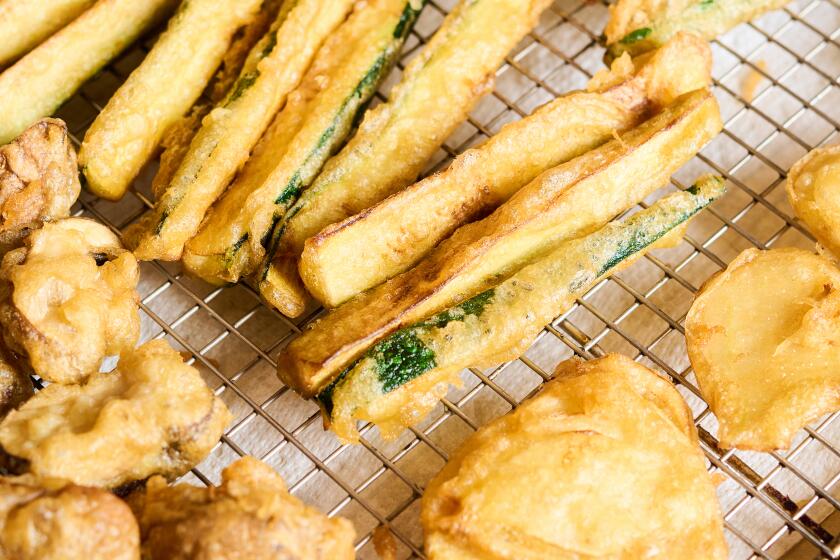Black beans
- Share via
They fashion rotisseries from Radio Flyer wagons. They weld custom grills into elaborate setups complete with coolers and keg compartments. They festoon tents with floral vines and adorn them with chandeliers. They’ve got huge buffets, big-screen satellite TVs and tons of charcuterie.
They’re tailgaters.
You could say the unofficial mascot of football and tailgating is the pig. There’s the perfectly grilled tenderloin, fat links of succulent sausages and racks and racks of ribs. And then there’s that whole suckling pig, gleaming as it turns on a huge, wheeled-in rotisserie. (And don’t forget the pigskin on the field.)
I didn’t really start watching football until after I graduated from USC, when a good friend patiently explained the sport over a season of pregame tailgates. My first forays were modest affairs with just a couple friends -- grilled chicken, a salad, a glass or two of wine at home before heading to the Coliseum. Before too long, I was hooked. I fell in love with the sport and, just as much, the tailgating.
The next year, I got season tickets. A few years ago, as the Trojans began to regain their greatness, I was just finishing cooking school. My tailgates became more elaborate, as my friends now expected to be wowed. I’d start the first home game with jerk chicken. In following weeks came sausages, carne asada, fajitas, tandoori chicken, Greek or Mediterranean grilled lamb and barbecue ribs. I’d prep everything at home, coming up with my own sauces, rubs and marinades, then haul it all to the game and finish it on the grill.
My tailgates have grown over the years, and now my crowd sometimes swells to 20. Friends bring chips and homemade salsas, mojitos, salads, mac ‘n’ cheese, brownies, cookies.
The Big Game -- USC versus UCLA , with Rose Bowl potential for both, in case you just arrived from the moon -- makes me crave pork chops. An overnight brine -- spiked with bourbon, maple syrup, mustard and rosemary -- infuses them with flavor and keeps them moist on the grill. For the extra point, we’ll stuff them with a mixture of goat cheese, bacon, spinach and roasted garlic. Brine the chops the night before the game, stuff them the morning of, and all you have to do at the game is throw them on the grill. First and 10.
How about some slow-cooked black beans? The day before, simmer them with some caramelized onions, and throw in a smoked ham hock or shank. When the beans are done, shred the tender meat from the hock and stir it in. On the big day, reheat the beans with some chopped tomato before or at the tailgate. Touchdown!
Now we need a two-point conversion. Finesse it with rustic corn bread. Bake it the night before in a cast-iron or oven-proof skillet; the light crunch of the coarse-ground cornmeal is perfect against the sweet corn kernels hidden in the grain. It’s great as is on game day but even better if you warm the pieces on the grill and serve them with whipped maple butter.
Here’s a surprise maneuver: celery root and apple slaw, with toasted pecans and currants -- now that oughta sack the quarterback. Dress it lightly with sour cream, cider vinegar and a touch of horseradish.
For appetizers and dessert, bring on the special teams -- your fellow tailgaters. The shutout is yours for the taking. Really, can there ever be too much food?
Sort through the beans, removing any little stones or debris. Rinse the beans and set aside.
Place a medium stock pot over medium heat. Add the oil, and when it’s hot but not smoking, stir in the onion and ham hock and saute until the onions are lightly caramelized, about 10 minutes. Add the garlic and continue sauteing just until it’s aromatic.
Stir in the beans and add 2 quarts water. Remove any beans that float. Bring the mixture to a strong boil, then reduce the heat to a gentle simmer. Cook the beans uncovered for at least 2 hours, until tender, stirring occasionally. Check the water level occasionally, adding additional water if it is absorbed too quickly (we added 1 3/4 cups over the 2-hour cooking period).
When the beans are tender, remove the ham hock, shred the meat and add it back to the pot, along with the chopped tomatoes, 1 teaspoon salt and one-fourth teaspoon pepper. Cook an additional 15 minutes, then taste and adjust the seasoning. The beans can be cooled and refrigerated at this point, then reheated before serving. They’ll keep for 3 days, refrigerated.
Get our Cooking newsletter
Get a taste of Los Angeles — and the world — with recipes and kitchen tricks from the L.A. Times’ Cooking newsletter.
You may occasionally receive promotional content from the Los Angeles Times.
















